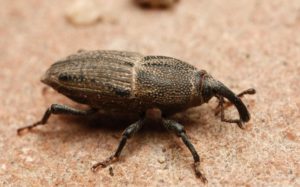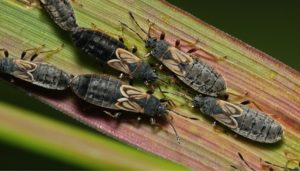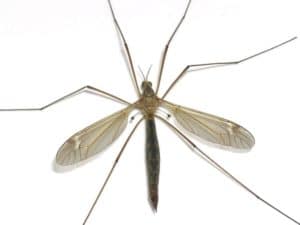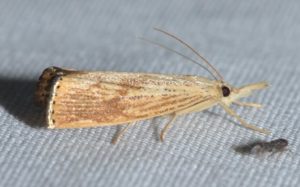SERVICE NAME: Insect Control & Treatments
TYPICAL COST: $50 and up
SERVICE AREA: Full service area
FREQUENCY: Varies
TIMING: Spring to Fall
COMMON ADD-ONS: Lawn Care Treatments
BENEFITS: Reduced lawn and shrub damage by insects
SERVICE NAME: Insect Control & Treatments
TYPICAL COST: $50 and up
SERVICE AREA: Full service area
FREQUENCY: Varies
TIMING: Spring to Fall
COMMON ADD-ONS: Lawn Care Treatments
BENEFITS: Reduced lawn and shrub damage by insects
Insect problems in your turf can be easily misdiagnosed as disease or even simply environmental stress from weather or temperature. The only way to be sure is to do a thorough inspection of your turf, and that means you have to get down on the level of the bugs themselves.
Insects can do a lot of damage to your turf, both above ground and below ground. These problems, if left unchecked, will brown your lawn in ugly patches, and even kill your entire turf. There is no control method that will ever rid yourself of them 100%, so it’s a constant battle, either way your mission shouldn’t be complete removal as some insects and bugs are actually beneficial, and as previously stated, it’s not possible to rid yourself of them entirely, insects are as tenacious as they are annoying.
The best thing you can do before you need professional help is to know thy enemy. All life is cyclical, and few things are more instinct driven and inevitable than insects. This means that we can predict their behavior and their telltale signs easily with some good observation. Knowing what you’re up against is paramount so you need to get down there in your turf and inspect it, below we will go over the insects you may encounter, how to identify them, and what we can do to help.
There are several different kinds of Insects that threaten your turf, these include:

Adult Bluegrass Billbug
Billbugs over-winter as adults and emerge mid-spring in April or May. In late May, females lay eggs in lawn grass stems and late in May and throughout June the larvae move into the soil and feed on roots and rhizomes. They remain near the soil surface feeding near the thatch layer when it’s moist and s soils dry, they go deeper. Billbug larvae can be differentiated from public enemy #1, the White Grub, by a few distinct features. The Billbug larvae have no legs and have yellow-brown heads. They are very small and look like puffs of rice.
Bluegrass Billbugs are named for, you guessed it, being known to infest Kentucky Bluegrass wherever it is found, but they can also be found in perennial ryegrass, fescue, and timothy. Common signs of infestation are patches of dying, or yellow/brown grass. The only way to know for sure it’s Billbugs is to get down and check for yourself for the bugs, Billbugs have a tendency to “play possum” so don’t be fooled if they look dead.

Chinch Bugs
Chinch bugs are similar to all the other insects on this page in that their damage looks the same. Chinch bugs survive the winter as adults seeking shelter from the cold and snow under shrubs, hedges and leaf litter, and they emerge in mid-springs around April or May. Once out The adult female will lay eggs in the lawn. In about 3 weeks time the eggs begin to hatch and the young chinch bugs begin feeding. Two or more generations can mature each season and once they do they can become a real problem.
Chinch bugs aren’t very common in Chicagoland as their reproductive process is usually interrupted by a species of fungus that’s prevalent due to the humid weather, however they can still appear so it’s always best to be vigilant. The best way to locate whether or not you have a treatable infestation of Chinch bugs is to use a bottomless can and push it into the turf you suspect is being harmed, then fill that up with water and if the chinch bugs that rise to the water surface make a solid line around the edges of the can, you have grounds to treat for chinch bugs.

Crane Fly
The European Crane Fly is probably something you’re already familiar with, referred to colloquially as “Mosquito-Eaters” or “Mosquito Hawks” these rather large looking insects ironically look quite a lot like huge Mosquitos themselves, but they are not. Despite their colloquial name impling so, they do not prey on Mosquitoes. Worse so, this species of Crane Fly is troublesome as, unlike their endemic cousins, they can infest your turf and cause damage to them when unchecked.
The adults usually lay eggs in in very moist turf, making them common pests for irrigated turfs. They lay their eggs around mid-autumn, September and October and their young hatch and burrow for the winter. In spring they emerge to eat until they grow large enough to molt and take to the skies. Identifying this pest is quite easy as like the others on this list you need only find significant amounts of their larvae in or under your turf, however unlike the others these larvae are large and brown, about 1 inch long making them easy to spot.
This is the single most destructive and common pest in Chicagoland. The larvae of these species are the single most common pest control issue in our local lawn care industry and as such we have a dedicated page and service for them specifically called “Grub Control”.

Sod Webworm Moth
Sod Webworms are somewhat rare in Chicagoland, as the larvae are very susceptible to diseases, particularly under cool, damp conditions. These conditions occur often enough in Illinois that outbreak numbers usually do not occur, but they are still present enough to be covered here. Sod Webworms are actually Moths, and like most of the other insects that invade your turf, the adults are harmless and it’s their young you need to look out for.
Seasons of drought on non-irrigated turf are usually what bring the moths in the first place, they lay their eggs in the early Autumn, their young hatch and begin bulking up for the winter, where they lay dormant until spring where they begin to damage your turf if there’s enough of them. The best way to identify if you have an infestation is to get down and look under your turf. The caterpillars are grayish to tan and covered with brown spots, they construct silk-lined burrows in your thatch layer where they hide during the day.